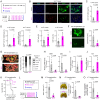Targeting macrophage circadian rhythms with microcurrent stimulation to activate cancer immunity through phagocytic defense
- PMID: 39744689
- PMCID: PMC11671381
- DOI: 10.7150/thno.100748
Targeting macrophage circadian rhythms with microcurrent stimulation to activate cancer immunity through phagocytic defense
Abstract
Rationale: Macrophage phagocytosis plays a role in cancer immunotherapy. The phagocytic activity of macrophages, regulated by circadian clock genes, shows time-dependent variation. Intervening in the circadian clock machinery of macrophages is a potentially novel approach to cancer immunotherapy; however, data on this approach are scarce. Microcurrent stimulation (MCS) promotes inflammation, proliferation, and remodeling, suggesting its potential to modulate macrophage function; however, its application has been limited. In this study, we investigated the impact of MCS on macrophage phagocytosis of cancer cells using mouse/human macrophage cell lines and various mouse/human cancer cell lines. Methods: Cells and mice received 300 µA, 400 Hz bidirectional pulsed MCS. Gene expression, protein expression, and phagocytosis activity were assessed in intraperitoneal macrophages collected from mice, as well as in RAW264.7, and THP-1 cells. Flow cytometry, population, phagocytosis activity, RNA-seq, and immunohistochemistry analyses were performed. Results: Noninvasive MCS prevented time-dependent reduction in macrophage phagocytosis of cancer cells by modulating the circadian clock genes. MCS also enhanced phagocytosis in mouse RAW264.7 and human THP-1 cells across various cancer types by promoting actin polymerization; similar in vivo effects were observed in mice. This enhancement occurred in abdominal macrophages of both sexes and was mediated by changes in clock gene expression. Specifically, suppressing the clock gene Per1 nullified the effects of MCS. Moreover, although macrophage phagocytosis typically declined during the dark period, MCS during the light period prevented this reduction. MCS also increased phagocytosis of peritoneally implanted cancer cells (4T1, ID8, and Hepa1-6) in mice, significantly reducing tumor engraftment and growth, and ultimately improving prognosis. Conclusions: The findings of this study suggest that targeting macrophage circadian mechanisms via MCS could enhance cancer immunity, offering new avenues for cancer immunotherapy.
Keywords: cancer immunotherapy; circadian rhythm; macrophage; microcurrent stimulation; phagocytosis.
© The author(s).
Conflict of interest statement
Competing Interests: The authors have declared that no competing interest exists.
Figures








Similar articles
-
Microcurrent stimulation activates the circadian machinery in mice.Biochem Biophys Res Commun. 2019 May 28;513(2):293-299. doi: 10.1016/j.bbrc.2019.02.022. Epub 2019 Mar 31. Biochem Biophys Res Commun. 2019. PMID: 30944082
-
Combinatorial macrophage induced innate immunotherapy against Ewing sarcoma: Turning "Two Keys" simultaneously.J Exp Clin Cancer Res. 2024 Jul 11;43(1):193. doi: 10.1186/s13046-024-03093-w. J Exp Clin Cancer Res. 2024. PMID: 38992659 Free PMC article.
-
Characterization of the molecular clock in mouse peritoneal macrophages.Biol Pharm Bull. 2007 Apr;30(4):621-6. doi: 10.1248/bpb.30.621. Biol Pharm Bull. 2007. PMID: 17409491
-
Promoting macrophage phagocytosis of cancer cells for effective cancer immunotherapy.Biochem Pharmacol. 2025 Feb;232:116712. doi: 10.1016/j.bcp.2024.116712. Epub 2024 Dec 13. Biochem Pharmacol. 2025. PMID: 39675588 Review.
-
Innate Rhythms: Clocks at the Center of Monocyte and Macrophage Function.Front Immunol. 2020 Aug 4;11:1743. doi: 10.3389/fimmu.2020.01743. eCollection 2020. Front Immunol. 2020. PMID: 32849621 Free PMC article. Review.
Cited by
-
Microcurrent stimulation induces cell death in p53-mutant and 5-FU-resistant breast cancer.J Biol Chem. 2025 Jun 24;301(8):110414. doi: 10.1016/j.jbc.2025.110414. Online ahead of print. J Biol Chem. 2025. PMID: 40570957 Free PMC article.
References
-
- Schmid P, Adams S, Rugo HS, Schneeweiss A, Barrios CH, Iwata H. et al. Atezolizumab and nab-paclitaxel in advanced triple-negative breast cancer. N Engl J Med. 2018;379:2108–21. - PubMed
-
- Horn L, Mansfield AS, Szczęsna A, Havel L, Krzakowski M, Hochmair MJ. et al. First-line atezolizumab plus chemotherapy in extensive-stage small-cell lung cancer. N Engl J Med. 2018;379:2220–9. - PubMed
-
- Veillette A, Chen J. SIRPα-CD47 Immune checkpoint blockade in anticancer therapy. Trends Immunol. 2018;39:173–84. - PubMed
-
- Anderson NR, Minutolo NG, Gill S, Klichinsky M. Macrophage-based approaches for cancer immunotherapy. Cancer Res. 2021;81:1201–8. - PubMed
Publication types
MeSH terms
LinkOut - more resources
Full Text Sources
Medical
Research Materials

